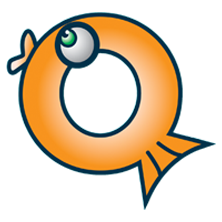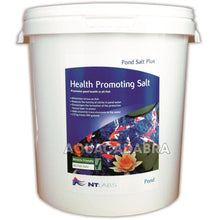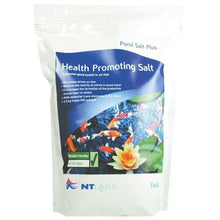
NT Labs Pond Salt
- Regular price
- From £12.75
- Sale price
- £12.75
SKU: 1013619
NT Labs Pond Salt is available in a number of sizes
Pay up to 30 days later or split your payment into three with Klarna.
Click here for more info.
- Product Description
- Reviews
- Finance
- Delivery & Returns
Product Description
- 2.5kg Bag – treats 625 gallons
- 9kg Bucket – treats 2500 gallons
Beneficial Effects of Salt in Koi Ponds
Most Koi keepers know that common cooking salt has numerous beneficial effects on fish, not least a marked anti-parasite activity and the promotion of healing. Some people maintain a permanent low level of salt in their pond. Others add a low level over the winter to help the fish survive these colder months. Salt has many other uses such as high strength anti-parasitic dips and the reduction of ammonia and nitrite poisoning.
This article will concentrate on salt's mechanisms of action on the physiology of the fish and parasites. The range of uses of salt will also be covered. To understand how salt exerts its healing and anti-parasitic effects, it is necessary to look first at the biological processes of diffusion and osmosis. Diffusion is the movement of a solute (a substance dissolved in water - e.g. salt) across a semi-permeable membrane from a region of high concentration to low concentration. Thus the sodium and chloride ions move across the membrane to even out the two concentrations. Osmosis is a similar principle but is fundamentally different. Osmosis is defined as the movement of a solvent - in this case water - across a semi-permeable membrane to a region of high solute concentration from a more diluted region of low solute concentration.
Let's look at this in some detail:
Imagine a solution of strong salt water and another solution of much weaker salt water. These two solutions are separated by a membrane that is termed semi-permeable. It allows the passage of certain ions but not others. Thus to even out the two solutions the water molecules will pass across the membrane from the weaker solution to the stronger solution until the salt concentration of the two solutions is equal. This process is osmosis. At the same time the salt ions diffuse from the high concentration solution across the membrane to the more dilute solution.
But how are these two processes relevant to fish?
The body fluids of the fish have a weak salt concentration, but the water in a freshwater garden pond has a significantly lower salt concentration. Thus what will happen is that water will tend to move into the fish across any semi-permeable surfaces. The main semi-permeable membranes exposed to the environment are the gills and the gut. However, not only is the water tending to move into the fish, but the salt ions tend to move out across the delicate gill membranes as well, leading not only to water uptake but diffusional salt loss also. So we can see that a freshwater fish is constantly fighting an influx of water and a loss of vital salts. If this were left unchecked the fish would soon die. Freshwater fish have evolved mechanisms to deal with this: they have extremely efficient kidneys which excrete water very rapidly. Also, to deal with the salt loss from the gills the efficient kidneys reabsorb salt from the urine. The gills take up sodium ions in exchange for hydrogen ions and chloride ions for bicarbonate ions, thereby taking up salt from the environment and removing unwanted ions from the blood. (Both hydrogen and bicarbonate ions will cause the blood pH to drop if they are allowed to accumulate.) The collective name for these processes of maintaining the body salts concentration is called osmoregulation.
Summary so far......
The koi swimming around in your pond have a higher salt concentration than the pond water. This leads to a natural movement of water and ions across the gills and gut. If left unchecked the fish would soon die; however, freshwater fish have evolved mechanisms to deal with this. Providing the fish is healthy these processes function normally. If the fish becomes stressed, parasitised, etc, then these essential processes can start to malfunction.
So how does adding salt to the water protect sick Koi?
A solution of salt that has the same concentration as that of a fish's body fluids is called isotonic. This level in terms we are used to would be 0.9% or 1½ oz/gal. A salt solution more concentrated than the fish's body fluids is termed hypertonic, and one less concentrated is termed hypotonic. If a Koi is placed in a hypotonic salt bath such as the ½ oz per gallon (0.3%) level maintained permanently or over winter by some Koi keepers, then the concentration gradient between the fish and the water is greatly reduced. Thus water influx and salt efflux are also reduced, relieving the sick, stressed or over-wintering fish. This level of salt also enhances mucus secretion by the goblet cells. This mucus then provides protection from parasites, bacteria, etc, and helps protect against colder temperatures. However this salt level is unnatural for the Koi, as they have evolved to deal with life in freshwater. Koi suffering from missing scales, ulcers or some other damage to the skin can be placed in an isotonic salt bath. This gives a balance between the body salts of the fish and the salt concentration in the environment. So there are very little ion fluxes at the wound site. This promotes healing and stops water accumulation at the wound. As the wound heals the salt concentration should be gradually diluted down to a hypotonic 0.3%, then to zero once the fish is fully recovered. If a Koi is placed in weakly hypertonic salt solution, there is a physiological action as the fish ceases to suffer water influx and ion efflux. There is also a metabolic stimulation, so the action of this weakly hypertonic long-term bath in salt is generally one of health enhancement. The protection given by this level of salt is excellent for sick fish and is sometimes used in fish transport. The bath duration should not exceed 12 hours with the level of salt at 1%.
The stronger the concentration of the salt treatment, then the shorter the amount of time the fish should be exposed. See figure two for rough guidelines of salt dips and baths and the relative times for each strength.
A strong hypertonic salt dip acts in a slightly different way to that of the weak hypertonic bath. The strong level of salt causes an osmotic pressure on the fish as salt ions try to diffuse into the fish and water is osmotically drawn out. This pressure acts as a skin irritant and causes inflammation, but more importantly this leads to excessive production of mucus. This mucohyperstimulation causes any parasites, fungi, bacteria, and any other skin debris to be sloughed off. So salt has beneficial effects on the fish at a range of concentrations. However, salt is best known within the koi keeping arena as an excellent anti-parasitic agent.
So how does salt kill the parasites that infect our Koi?
We have seen how ions and water can pass across semi-permeable membranes by diffusion and osmosis when there is a potential difference in solute concentration. Thus if the parasites are placed in a hypertonic medium, then they will suffer diffusional ion uptake and osmotic water loss. The parasites have a much lower isotonic point than the fish. Many single celled parasites are killed at 0.3% salting although some are beginning to show resistance (e.g. certain Asian Trichodinids). Larger parasites such as the flukes may need a higher level or longer duration. Visible macroparasites such as leeches or Argulus need strong hypertonic dips right at the limit of the fish's salt tolerance. Generally, the stronger the salt bath the quicker the parasites will die. See figure three. Thus parasites are killed by water loss causing their cells to collapse. However, in a strong hypertonic dip it is not only the osmotic shock that kills the parasite, there is also a direct toxicity from the sodium (Na) cation. When sodium is taken up there is usually an equal amount of potassium or calcium cations taken up with it. However, in a strong hypertonic dip, it is only the
Na cation (and the Cl anion) that is greatly elevated. Thus Na accumulates in unusually large amounts, leading to toxicity in the parasite cell. This is why sea salts are less effective as high strength anti-parasite dips, as there is also elevated calcium and potassium.
Other uses
If your biological filters have malfunctioned for some reason, and you are recording excessive levels of ammonia and nitrite, then the addition of salt to the pond can be extremely beneficial. Irritation due to ammonia can be relieved by the mucostimulation increasing the protective slime coating. Nitrite toxicity is lessened due to the chloride anion competing with the nitrite anion for entry into the gills.
Conclusions:
Koi have adapted to live in freshwater and have evolved mechanisms to deal with the problems this causes. If the fish becomes sick then elevating the level of salt to a mildly hypotonic level confers physiological protection on the fish, and should reduce the parasite load. Very sick or heavily parasitised fish can be placed in a short-term strong hypertonic dip to rapidly kill parasites and promote mucous production.
Thus to control parasites and boost the health of sick fish, reach for the salt!
Reviews
Finance
Aquacadabra acts as credit broker/intermediary and not as a lender.
Klarna's credit products are provided by Klarna Bank AB, which is authorised and regulated by the Swedish Financial Services Authority, with limited supervision by the Financial Conduct Authority. More information can be found here.
Newpay finance options are provided through Deko’s platform by NewDay. P.D. Aquatics Ltd, t/a Aquacadabra is an Introducer Appointed Representative of Pay4Later Ltd, t/a Deko, which is authorised and regulated by the Financial Conduct Authority (ref no 728646) and is a credit broker, not a lender. NewDay Ltd is authorised and regulated by the Financial Conduct Authority (ref no 690292) and is authorised by the Financial Conduct Authority under the Payment Services Regulations 2017 for the provision of payment services (ref no 555318). More information can be found by clicking the newpay option above, or in the Newpay FAQs.
Delivery & Returns
We really want you to be happy with the product that you've received. If however, when the goods arrive they're not what you want, then no problem - we have a 60 day no quibble return guarantee. Just let us know that you're going to return the item(s) by contacting us (stating your Order Number) and complete the returns packing slip that will have been included with your delivery. This will help us to quickly identify the item that you have returned (unopened and unused) - and we'll put a refund through for you.












